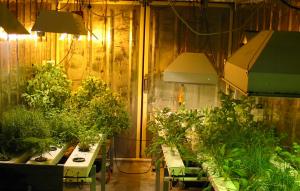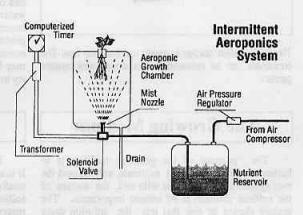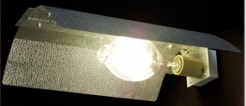This post may contain affiliate links. That means if you click and buy, I may receive a small commission. Please read my full disclosure policy for details.
The Urban Farmer, Issue #028 * Aeroponics * Keep it Cool * Wilted leaves?

“A garden is a friend you can visit any time.” ~Anon
ADVANCED HYRO SYSTEMS: AEROPONICS

Aeroponics is a hydroponics system where roots are saturated with fine drops (a mist or aerosol) of nutrient solution. The method requires no substrate and entails growing plants with their roots suspended in a deep air or growth chamber with the roots periodically or continuously wetted with a fine mist of atomized nutrients.
Since inventor Richard Stoner commercialized aeroponic technology in 1983, aeroponics has been implemented as an alternative to water intensive hydroponic systems worldwide. Aeroponics is also widely used in laboratory studies of plant physiology and plant pathology. Aeroponic techniques have been given special attention from NASA since a mist is easier to handle than a liquid in the zero gravity environment of outer space.
Advantages of aeroponics over regular hydroponics:
- Excellent aeration is the main advantage of aeroponics.
- Any species of plants can be grown in a true aeroponic system because the micro the environment of an aeroponic can be finely controlled.
- Suspended aeroponic plants receive 100% of the available oxygen and carbon dioxide to the roots zone, stems and leaves, thus accelerating biomass growth and reducing rooting times. NASA research has shown that aeroponically grown plants have an 80% increase in dry weight biomass (essential minerals) compared to hydroponically grown plants, while using 65% less water.
- Aeroponically grown plants requires only ¼ the nutrient input compared to hydroponics.
Disadvantages of aeroponics:
The main disadvantage of aeroponics is the unforgiving nature of the process. What happens in a power failure? With aeroponics, when the mist stops, the plants quickly die. With regular hydroponics, you have up to a day or two to get moisture to those roots. The bottom line? Unless you have a backup generator or can assure no power failures during your growing season, stick to simpler hydro systems.
Here is one popular beginner’s unit you might like to purchase to “get your feet wet” in the aeroponics method:
BACK TO THE BASICS: KEEP IT COOL!

Your biggest obstacle to a successful hydroponics garden will be heat. The supplemental lights required to grow flowering or fruiting crops are HOT!
If you’re growing inside, you need to think about this. Any garden prefers a cool climate to an overly hot one. The magic numbers: keep the temp between 65-80 degrees.
Here are some ways you can cool things off:
*Crack the window open in cool/cold weather.
*In winter, close off some of the heat getting to the grow room.
*Use a fan to blow heat away from the plants.
*Get a grow-light equipped with exhaust tubing & inline exhaust fan.
*Keep A/C thermostat at 72-76 degrees. Can’t afford that?
Buy a portable A/C or small window unit for your grow-room.
Hydro Tip of the Month
Got wilted leaves? This is usually a sign of over or under watering, or climate too dry or too hot [try watering with clear water, or cooling down the area]. Also, consider a possible wilt disease: leaves curled up, dried out, and dead leaves
(see Common Plant Diseases).
We hope you have enjoyed this issue of The Urban Farmer Ezine. Each month, we will bring you another inspiring photo, gardening quote, or idea, plus fresh new hydroponics news, techniques, and products.
Insiders tips to get you growing…

~Stella and Simon

Reply